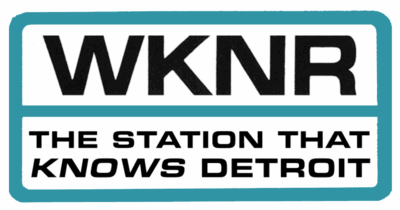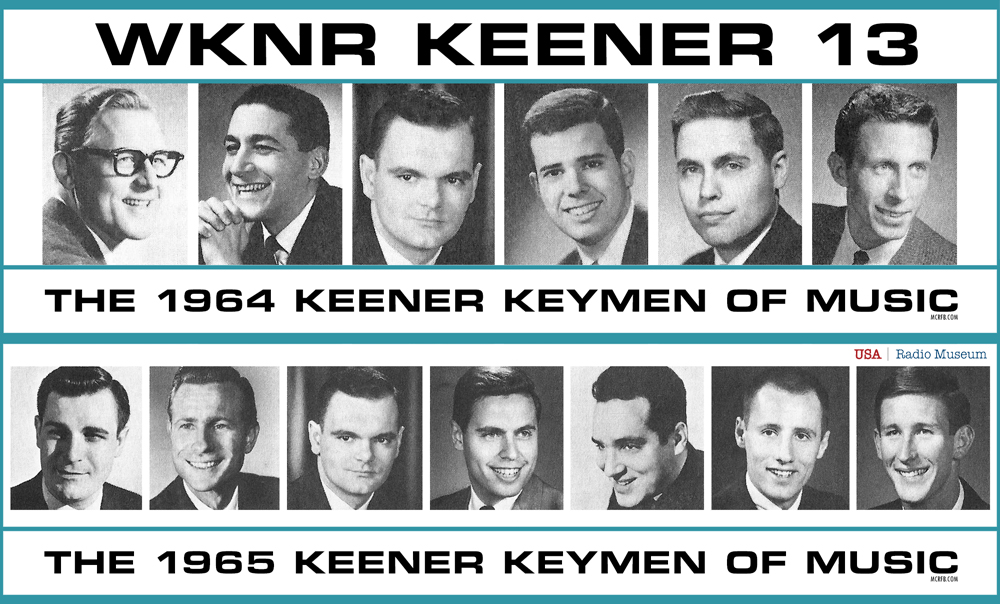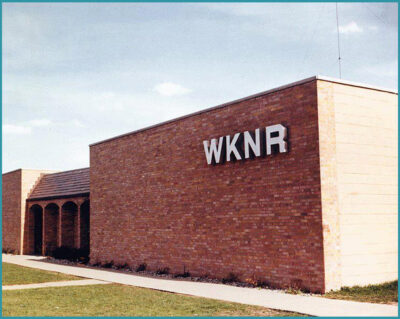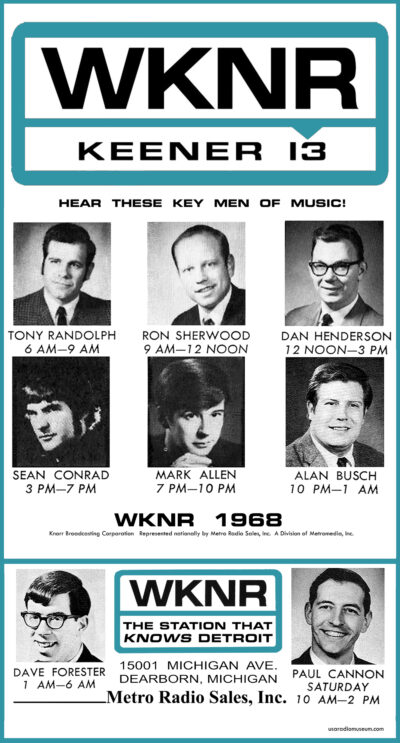Detroit Radio History: A Reflection Today on WKNR's Iconic Legacy On April 25, 1972, Detroit lost a radio titan as WKNR-AM, affectionately
Detroit Radio History: A Reflection Today on WKNR’s Iconic Legacy
On April 25, 1972, Detroit lost a radio titan as WKNR-AM, affectionately known as “Keener 13,” signed off from the 1310 AM frequency. Once the crown jewel of the Motor City’s airwaves in the 1960s, WKNR left behind a legacy that continues to resonate with generations of Detroiters.
Originally operating as WKMH-AM, the station underwent a groundbreaking transformation on October 31, 1963, rebranding itself as “Radio 13.” The shift was dramatic, but success came quickly. By early 1964, WKNR had skyrocketed to the top of Detroit’s radio rankings, becoming the most popular station in the area. Its innovative approach and engaging content kept it firmly planted as the No. 1 station through the first half of 1967, capturing the hearts of listeners with its dynamic Top 40 format.
However, even the mightiest can stumble. In April 1967, WKNR began to feel the strain of competition, particularly from CKLW, the Canadian-based station just across the Detroit River. At the time, CKLW was undergoing a major transformation under the guidance of RKO consultants Bill Drake and Paul Drew. The duo introduced the “Boss Radio” format, a strategy that had already proven immensely successful at 93 KHJ in Los Angeles. By the end of 1967, CKLW had eclipsed WKNR, claiming the title of Detroit’s most popular radio station. Its immense 50,000-watt signal, which covered three Canadian provinces and reached 28 states at night, far outpaced WKNR’s 5,000-watt transmitter, which struggled to maintain coverage east of Detroit after sunset.
Despite this new challenge, WKNR did not lay down without a fight. Management implemented significant changes, including a revamped programming strategy that sought to distinguish the station from CKLW. By late 1971, WKNR had adopted a new identity as “American Rock and Roll” radio. It trimmed its playlist, focusing on the top 15 hits of the week and selectively previewing other tracks. Yet these efforts couldn’t stem the tide. WKNR continued to lose ground, not only to CKLW but also to FM stations like WABX, which embraced a “free-form” underground style that resonated with younger, more experimental audiences.
As the battle for listeners intensified, changes swept through WKNR’s personnel and programming. By early-1968, notable names like Bob Green, Jerry Goodwin, Ted Clark, and Scott Regen left the station, making way for a new lineup of voices, including Sean Conrad and Edward Alan Busch. Despite these shifts, WKNR couldn’t reclaim its former glory. By late 1971, ratings showed a significant decline, with the station’s cumulative daily audience dropping to 377,300—a sharp contrast to CKLW’s dominance.
 WKNR’s decline was not only a story of competition but also a reflection of broader trends in the radio industry. FM radio was on the rise, offering superior sound quality and innovative programming. WKNR-FM attempted to compete with an album-oriented rock format but found little success against established FM powerhouses like WABX. Eventually, by 1971, WKNR-FM shifted to a “Stereo Island” easy-listening format, targeting a different audience altogether.
WKNR’s decline was not only a story of competition but also a reflection of broader trends in the radio industry. FM radio was on the rise, offering superior sound quality and innovative programming. WKNR-FM attempted to compete with an album-oriented rock format but found little success against established FM powerhouses like WABX. Eventually, by 1971, WKNR-FM shifted to a “Stereo Island” easy-listening format, targeting a different audience altogether.
But ultimately, the end came on a brisk, chilly Tuesday morning, April 25, 1972. Just before 8:00 a.m., as the sun rose over Detroit, WKNR’s final moments on air were marked by an emotional farewell from DJ John McCrae. His voice wavered as he thanked listeners for nearly a decade of support, leading up into the Byrds’ 1965 hit,”Turn, Turn, Turn.” As the last notes of the song faded, so did the magic of Keener 13. But while the station officially consigned itself to Detroit radio history that morning, its legacy endured.
In 2002, the story of WKNR found new life online. Scott Westerman and Steve Schram created Keener13.com, a tribute site dedicated to preserving the station’s history. Over the past two decades, the site has become a treasure trove of memories, offering a glimpse into the golden age of the WKNR era in the Motor City.
WKNR was more than just a radio station. It was a cultural touchstone that reflected and shaped the community it served. Its news department set a high standard for journalistic excellence, keeping Detroit informed during a turbulent era. Its music and personalities created moments that are still cherished by listeners today.
As WKNR legend Bob Green once said, “The WKNR experience provided some of my happiest radio memories.” For many Detroiters, those memories are a shared legacy, a testament to the power of radio to connect with its audience, entertain, and inspire.
WKNR-AM | John McCrae | April 25, 1972
Audio Digitally Remastered by USA Radio Museum
The Voices Behind the Keener Sound: WKNR’s Radio Legends and Personalities
WKNR-AM’s incredible success was due in large part to the talent, charisma, and unique personalities of its DJs who captured the hearts of Detroit listeners from 1963 to 1972. These voices became synonymous with “Keener 13,” turning the station into an icon of Detroit radio lore.
When WKNR first launched in November 1963, its original lineup included Mort Crowley, Bob Green, Robin Seymour, Gary Stevens, Jim Sanders, and Bill Phillips—all pioneers of the station’s vibrant sound. By 1964, fresh talent like Sam Holman (briefly for two weeks), Jerry Goodwin, and Swingin’ Sweeney joined the roster, followed later that year by Paul Cannon.
May 1965 marked the arrival of two legendary names: Dick Purtan and Scotty Regen, both of whom became central figures in WKNR’s golden era. Ted Clark, J. Michael Wilson, and Jim Jeffries also came aboard that same year, enriching the station’s dynamic presence on the airwaves.
The Keener lineup continued to evolve with time. By January 1967, WKNR welcomed Steve Robbins, Dave Forster, and Bob Harper to the team. In 1968, a fresh wave of voices arrived: Sean Conrad, Edward Alan Busch, Ron Sherwood, Dan Henderson, Mark Allen, Gary Mitchell, and Tony Randolph added their unique flair to Keener’s sound. On the FM side, Russ Gibb made his mark with his distinctive programming style.
During the late 1960s and early 1970s, WKNR continued to attract radio talent who would become legends in their own right. Jerry Goodwin found his niche on the FM side (1968). Retained by station programmer Frank Maruca, Paul Cannon, he remained as music programmer. Gary Granger, Tom Neal, Chris Ryan, and John Small (FM) Dan Carlysle (FM) joined the station in 1969. The following year, Bob Green made his triumphant return to WKNR, adding his unmistakable energy to the lineup. 1970 also welcomed Mac Owens, Pat St. John, and the return of Scotty Regen (having left in 1968) back on Keener 13, who had spent time at the Big 8 CKLW. By 1971, WKNR added Bill Garcia, Jim Tate, Pat St. John (formerly of CKLW; XM today!), and Chuck Bennett to its roster, bringing fresh voices to the airwaves during the station’s final era.
WKNR-FM | Jim Cutler | April 25, 1972
Audio Digitally Remastered by USA Radio Museum | A USARM Special Acknowledgement: This featured audio is courtesy of Jim Nuznoff, of Port Charlotte, FL.
The final chapter of WKNR’s history in 1972 featured a talented lineup that included Robin Stone (Jim Kerr of WPLJ fame in New York!), John McRae, Bob Chenault, Greg Innis, and Brother Marcus. These voices carried WKNR into its final moments, creating unforgettable memories for Detroit listeners before the station signed off for the last time.
Today, 53 years after its final broadcast, the legacy of WKNR-AM continues to echo across generations. It serves as a powerful reminder of a bygone era when radio wasn’t merely a source of entertainment but a vital thread weaving the fabric of a community together. WKNR was more than music—it was companionship, a shared experience that connected Detroiters through the challenges and triumphs of the 1960s and in the early 1970s. It bridged gaps, fostered cultural identity, and sparked collective memories that still bring smiles and nostalgia to those who remember tuning in. Though its signal has long faded, the magic of Keener 13 remains undiminished, living on in the stories, laughter, and emotions it evoked—a timeless tribute to the transformative power of a great ’60s Detroit radio station and the enduring spirit upheld while serving a community that still treasures the memories, the voices, and the music that defined an era.
_____________________
A USARM Viewing Tip: On your mobile or tablet device? Finger-tap the above images (in the post) and stretch image across your device’s screen for LARGEST digitized view.



